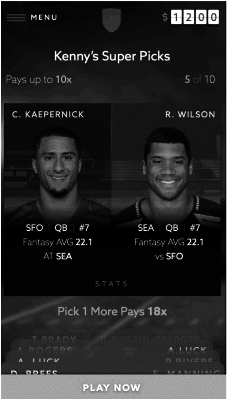| CPC G06F 3/0482 (2013.01) [G06Q 50/34 (2013.01); G07F 17/326 (2013.01); G07F 17/3239 (2013.01); G07F 17/3244 (2013.01); G07F 17/3288 (2013.01); G07F 17/3295 (2013.01)] | 23 Claims |

|
1. A system for providing a skill-based game, the system comprising:
a non-transitory storage medium storing machine readable code;
at least one activity server system comprising a processor configured to execute the machine readable code and to communicate over a wide area network with a plurality of presentation computing devices, each distinct one of the presentation computing devices associated with a distinct one of a plurality of users, and to receive information from the plurality of presentation computing devices; and
a device storage system coupled to the activity server system storing (i) information concerning the plurality of users, each user identifiable by a user account, and (ii) event data pertinent to a set of events and a pool of participants in the set of events;
wherein, the machine-readable code, when executed by the activity server system, causes performance of computer processes comprising:
evaluating, by the activity server system, using an automated process based upon statistical analysis, a set of the participants in the pool of participants to determine a statistically expected fantasy score performance by the set of participants in the set of events;
serving, over the wide area network, to the presentation devices:
(A) a set of matchups selectable by a given user within a graphical user interface on the given user's presentation device, wherein each selectable matchup of the set offers, to the given user, an opportunity selected from the group consisting of: opportunity (i) and opportunity (ii), wherein the opportunities are as follows:
opportunity (i): with respect to first and second participants in the pool of participants and provided to the given user by the activity server system, to select the first participant, in a manner indicating that the first participant is projected by the given user to achieve a first fantasy score superior to a second fantasy score of the second participant, and
opportunity (ii): with respect to a third participant in the set of participants and provided to the given user by the activity server system, to select whether a fantasy score of the third participant will be over, or under, the expected fantasy score of the third participant; and
(B) an associated fixed odds payout that is based on a number of matchups selected by the given user;
causing the presentation device of the given user to display the set of matchups and the associated fixed odds payout,
receiving, separately, from the presentation devices, over the wide area network, user roster data characterizing a set of user-selected winners;
after occurrence of at least one event in the set of events, updating the event data pertinent to participants in the set of events based on a set of outcomes associated with the set of events; and
using the updated event data to determine if the given user is a winner based on the selections by the given user, wherein determination of whether the given user is a winner or loser is based solely upon the given user's selections and not on selections of other users.
|